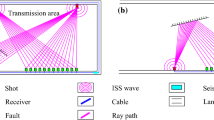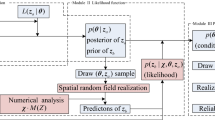Abstract
In recent years, coal mine has applied shield tunneling machines to roadway excavation to improve production efficiency. Geological condition is an important factor that determines the efficiency of shield machines. The shield machine is most favorable for medium to hard surrounding rocks such as limestone and sandstone. Therefore, the lithology prediction of the location of a planned excavation roadway becomes the core issue in improving the efficiency of the shield machine. At present, seismic inversion is an essential method for lithology prediction. However, in Yangquan Xinjing area, missing P-wave logging curves affects the impedance inversion. Therefore, using existing logging curves to generate missing P-wave logging curves and using sandstone exposure data to continuously update lithology distribution prediction results are of great interest. In this study, logging curves were first pretreated by standardization to ensure the inversion effect. Because of the missing acoustic logging curves, the random forest regression algorithm was introduced using density, natural gamma, apparent resistivity, and spontaneous potential curves as characteristic variables to establish a curve regression prediction model. Then, P-wave logging curves were acquired. After a full analysis of the principles of acoustic and gamma curves, a quasi-acoustic curve is constructed, and a quasi-acoustic inversion was performed. The top and bottom interfaces of the K7 sandstone were interpreted on the inversion data body. The interpreted horizon information was converted from the time domain to the depth domain. The predicted results agreed well with the exposed data. At the same time, combined with the lithology exposure data from the shield tunneling machine, the distribution prediction of the K7 sand body in the target roadway section was updated and iterated many times, which provided effective guidance for the optimization of the tunneling route of the shield tunneling machine.
Similar content being viewed by others
References
Krygowski, D. A., Cluff, R. M., 2015, Approach Speeds Data Interpretation[J]. The American Oil & Gas Reporter, 58(11):86,88,90–91.
Kevin, P. D., et al., 2004, Genetic-algorithm/neural-network approach to seismic attribute selection for well-log prediction[J]. Geophysics, 21(1): 212–221.
Wendt, W. A., Sakurao, S. T., Nelson, P., 1986, Permeability prediction from well logs using multiple regression [M]. Amsterdam: Elsevier, 1986:181–221.
Eskandari, H., Rezaee, M. R., Mohammadnia, M., 2004, Application of Multiple Regression and Artificial Neural Network Techniques to Predict Shear Wave Velocity from Wireline Log Data for a Carbonate Reservoir, South-West Iran[J]. CSEG Recorder, 29(7): 40–48.
Rolon, L., Mohaghegh, S. D., Ameri, S., et al., 2009, Using artificial neural networks to generate synthetic well logs[J]. Journal of Natural Gas ence & Engineering, 1(4–5):118–133.
Alizadeh, B., Najjari, S., Kadkhodaie-IlkhchI, Ali., 2012, Artificial neural network modeling and cluster analysis for organic facies andburial history estimation using well log data: A case study of the South ParsGas Field, Persian Gulf, Iran[J]. Computer&geosciences, 45:261–269.
Mo, X., Zhang, Q., Li, X., 2016, Well logging curve reconstruction based on Genetic Neural Networks[C] International Conference on Fuzzy Systems & Knowledge Discovery. IEEE, 2016.
Long, W., Di, C., 2016, Aminzadeh, F., Pseudo density log generation using artificial neural network[R]. 2016.
Salehi, M. M., Rahmati, M., Karimnezhad, M., et al., 2016, Estimation of the non records logs from existing logs using artificial neural networks[J]. Egyptian Journal of Petroleum, 26(4):957–968.
Zhang D. X., Chen, Y. T., Meng, J., 2018, Logging curve generation method based on cyclic Neural network [J]. Petroleum Exploration and Development, 45(4): 598–607.
Zhang, X. F., Dong, Y. C., Shen, G. Q., et al., 2005, Application of curve Reconstruction technique in logging constrained inversion [J]. Petroleum Exploration and Development, 32(03):70–72.
Shi, L., Wang, C. J., 2004, High-resolution seismic inversion using quasi-acoustic curves [J]. Journal of Southwest Petroleum University, 26(05):18–20+86.
Yang, X. L., Liu X. P., Zhao, X. Q., 2007, Application of Curve Reconstruction inversion in igneous Reservoir prediction [J]. Journal of Xi’an Petroleum University (Natural Science edition), 22(06):32–35.
Li, S. Z., Shang, J. L., 2011, Application of inversion of quasi-acoustic curve reconstruction in liutun reservoir prediction [J]. Complex reservoirs, 4(04):26–28.
Yang, Z. L., Zhou, L., Peng, W. L., 2008, Application of BP neural network technology into reconstruction of acoustic well logs [J]. Journal of Southwest Petroleum University (Natural Science edition), 30(001):63–66.
Fu, Z. G., Yin, C., Zhang B. L., 2005, Detection of sand body distribution using wavelet parameters [J]. Petroleum Geophysical Exploration, 2005(03):343–348.
Yue, Y. X., Wang, J., 2007, SVM method for predicting the thickness of sandstone[J]. Applied Geophysics, 4(4): 276–281.
Zhang, S. H., 2008, Application of probabilistic Neural network technology in Lithological Inversion of Heterogeneous layers [J]. Journal of Petroleum Sciences, 29(4): 549–552.
Cui, X. L., Li, W. P., 2015, Multi-information Prediction and Evaluation of Water-rich sandstone in fully mechanized mining roof [J]. Coal Field Geology and Exploration, 43(1): 43–47.
Liu, W. M., Liu, W. J., Pei, G. D., 2016, Prediction of coal seam roof lithology by Multi-attribute Neural network Inversion [J]. Coal Field Geology and Exploration, 44(1): 103–106.
Zuo, W. H., Shan, R., Zhu, W., 2018, Application of Lithology Inversion in identification of coal seam roof sand body [J]. Coal Field Geology and Exploration, 46(2): 184–189.
Author information
Authors and Affiliations
Corresponding author
Additional information
This work was supported by the Joint Fund of the State Key Laboratory of Coal Resources and Safe Mining-Beijing University Outstanding Young Scientists Program Project (BJJWZYJH01201911413037); State Key Laboratory of “Coal Resources and Safe Mining” Open Fund (SKLCRSM19ZZ02)
Shi Suzhen is an associate professor and master supervisor at the China University of Mining and Technology (Beijing). Her main work is seismic data interpretation and inversion. Her contact information is State Key Laboratory of Coal Resources and Safe Mining, China University of Mining and Technology (Beijing), 11 Ding Xueyuan Road, Haidian District, Beijing 100083, China. Her email address is ssz@cumtb.edu.cn.
Rights and permissions
About this article
Cite this article
Shi, Sz., Gu, Jy., Liu, Zl. et al. Tunneling route prediction of shield machine based on random forest P-wave generation. Appl. Geophys. 21, 69–79 (2024). https://doi.org/10.1007/s11770-021-0960-9
Received:
Revised:
Published:
Issue Date:
DOI: https://doi.org/10.1007/s11770-021-0960-9




